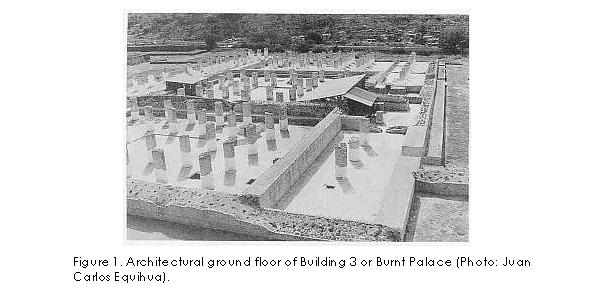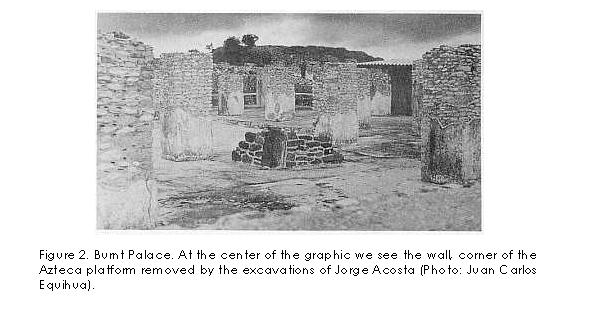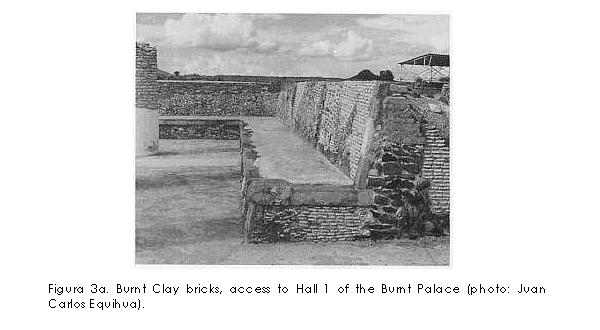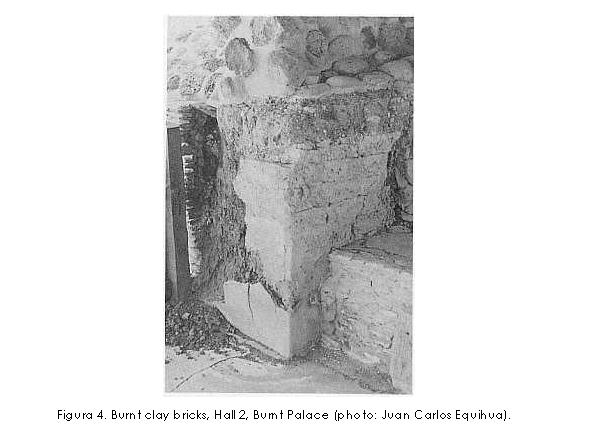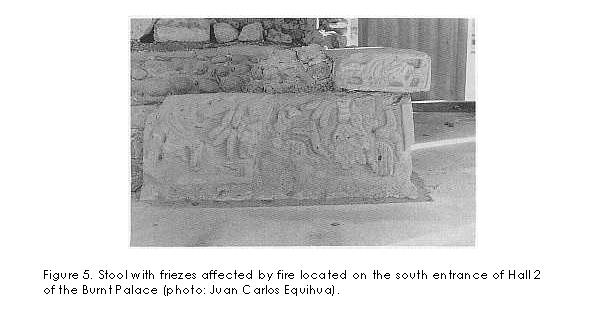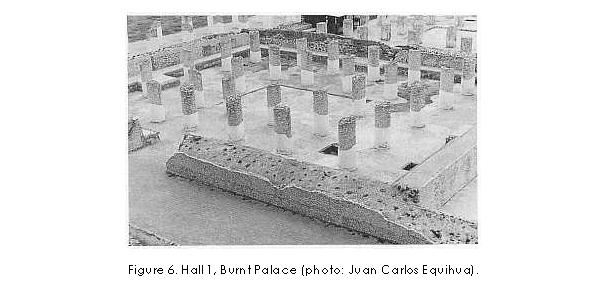The works of archaeological excavation performed in Tula1, directed by archaeologist Jorge R. Acosta since the beginning of 1940 emerged from the heart of the then recently founded Instituto Nacional de Antropología e Historia [National Institute of Anthropology and History], and were encouraged by the Sociedad Mexicana de Antropología [Mexican Society of Anthropology] by means of the reflexive participation of Wigberto Jiménez Moreno, Paul Kirchhoff, Ignacio Marquina, Miguel Othón de Mendizábal, Roberto Weitlaner and Alfonso Caso, among others. The objective of these works was to explore the correlation that could exist between the tradition stated in historical documents and the archaeological ruins located outside the community of Tula de Allende in the state of Hidalgo, known by the inhabitants as El Cerro del Tesoro [The Hill of Treasure], a hobby consisting in the search for objects with ancestral roots.2
In those times, the source of knowledge and reflection about the Tolteca society revolved around historical documents, particularly about the characters and stories that appear in the Anales de Cuauhtitlan [Annals of Cuauhtitlan] and the Historia Tolteca Chichimeca [Tolteca Chichimeca History]; whereas the archaeological project began to remove the dust from the monuments and the historical memory of the great Tollan. Fifty years before, Mr. Desiré de Charnay had left unfinished his explorations of Tula of the Toltecas, and also of other buildings. 3 During those fifty years, the memory of the Cemanahuac people, shaped in the documents of the first centuries of Colonial times in Mexico, was influenced by the opinion of the scholars of the “time”, thus changing into scientific reflection. The change from one to the other, from historical register to opinion and interpretation of facts, caused -at least temporarily- the change of place from Tula to Teotihuacan, a virtual change fifty years before the appearance of the technology that would make it possible.4
After two decades of exploration, Jorge R. Acosta finished his work to expose the surface of the buildings, from the time when Tollan had been the great metropolis and the center of an empire. Apart from Acosta, other people thought when looking at the archaeological monuments of the Cerro del Tesoro that the Toltecas, the great artisans and craftsmen of the Mesoamerican civilization, had not left their historical legacy shaped on the buildings due to the very exiguous quality of the materials used in the construction of their temples and palaces.5
Nowadays, the remains lie forgotten, archaeological monuments left to the design of the forces of nature and of the soles of the most prestigious brands of shoe manufacturers: Tula has become part of globalization.
Nine years ago, we commemorated fifty years of the beginning of the archaeological research in Tula by the part of the Instituto Nacional de Antropología e Historia; another fifty years have elapsed and the memory of those who reflected on the Tollan historical fact seems to be asleep. Perhaps this is due to mere coincidence but I wonder why the resemblance we find between the distance of intense moments of reflection on this historical fact, and that of the relationship between flint, reed, house and rabbit cycles?
Once more, oblivion has generated the movement from the heart of the INAH to rejuvenate the facades of archaeological monuments and history is been dusted again. Since 1997, INAH’s Hidalgo Center has planed a Project of Research and Archaeological Maintenance in the Archaeological Zone of Tula, Hidalgo6 and the archaeology section has tried to go ahead the destructive action caused by the anarchic urbanism process in Tula de Allende. However, in most of the cases we have only managed to document the traces of destruction of the archaeological strata; bones, tepalcates, tepetates, clay bricks, some rocks and obsidian cast aside to the edges of the ground hollows, a new stratigraphic fact of destruction and creation, a new pit of deposition where the underlying data of history lie forever, and that takes away from us the opportunity of documenting the stratigraphic sequence, the only source of independent data that allows us to evaluate historical memory.
The explanation of the stratigraphic fact is the object of archaeological study. Excavation, the register of ‘order of relations’ in a sequence of stratigraphic units and the interpretation of the sequence abstractions are the most important tasks of archaeological work, which once known, become a historical document and an integral part that increases the memory of an aspect of the place’s history. The culmination of archaeological excavation works and their communication belong to the field of historical facts, beyond the domain of tradition and of the reflection that may rise when trying to incorporate them in an explanation.
When the archaeologist makes public the order of the stratigraphic sequence, he/she exhibits before the rest of the academic community an aspect of history that underlies the soil of the landscape transformed by social action. The academic community is in charge of incorporating the stratigraphic fact into the reflection on a particular or general aspect of society. The archaeological contribution in the research process of the Tolteca society is subordinated to the study, spreading and preservation of the stratigraphic fact, that is, in those places where there are still aspects of our history deposited.
Archaeology of objects
What is the historical legacy recovered in Tula by archaeological work? What has been the archaeological contribution on the Tolteca society? These are two questions we will now try to answer.
The critical evaluation we undertake tries to go beyond stating the rights and wrongs of those who have taken part in the research process of the archaeological zone of Tula, Hidalgo. Through the formulation of these questions we try to examine one of the most important aspects for the research of the Tolteca society which relates to the theoretical justification of the scientific method in archaeological work and to the scientific explanation of the Tolteca society.
We do not intend to make an incursion in the discourse of the philosophy of science; the evaluation is directed towards the process of archaeological research to clarify what elements distinguish archaeological excavation from the excavations performed by engineers, geologists or architects in their scientifically based work, and how these data are used to explain the Tolteca society. Apart from valuable interpretations, what are the substantive data archaeologists have shared with the academic community devoted to the fact of Tollan?
To answer these questions we will resort to archaeological reports, revealed by Jorge R. Acosta, and we will analyze the excavation process that uncovered Building 3, or Burnt Palace, by consulting the graphic record of photographs, diagrams, plans and the observation of the vestige surfaces already restored and rebuild. In a certain moment, the excavations of the vestiges provided the archaeologist and all the historians the kind of evidence necessary to answer one of the most important questions of the time, which will always be a reason for research: what happened to the Toltecas? Acosta must have been convinced that his findings revealed that the declarations of ancient documents had a real historical background. The more his exploration extended, the more the amount of evidence coincided with the creation of the Tolteca world image.
When we visit the archaeological zone of Tula, we see the work of archaeologist Jorge R. Acosta. The surface of the archaeological monuments and the place of the caryatids and the columns of carved stone on Building B were exposed by the work team of the researcher, and the design of their position was performed by Acosta, as a demonstration of the archaeological existence of the Toltecas and to provide truthfulness to the stories that affirm the Tolteca civilization was destroyed by the barbaric incursions of the Chichimecas. We use the term design because, in several places, archaeological strata of Aztec stages were removed to then rebuild the surface of Tolteca architecture, including the caryatids.
In the archaeological reports presented by Acosta he mentioned that the excavations were performed stratigraphically, and although written communications are the only existing registers of the process of stratum deposition, the discourse is limited to presenting the finding of objects, tools and architectural elements. Never does he stop to describe the stratigraphic fact. By means of analysis of pottery objects, Acosta suggests an interpretation of the findings. Aztec pottery is found above most of the restored and rebuilt surfaces of the archaeological zone; Aztec vestiges were superimposed to the buildings destroyed by fire, and they were contemporary to the lootings in Buildings B, C and number 3.
Acosta managed to order the data from the excavations and he integrated them in the explanatory discourse of the facts that had occurred in Tula, adhering to the events stated in historical writings. For the author, there was no doubt: the burnt buildings were an irrefutable proof of the destruction of the Toltecas by the Chichimecas.7 Since that discovery to this day, the findings and the explanations of the research have been used without any exam that would reflect on the correlation between register and archaeological interpretation.
Architecture and objects of the Palace
The great fire that took place on Building 3 is one of the archaeological proofs that have been used to explain the disappearance of the Toltecas. However, when reviewing the contents of the archaeological reports, there is a series of data that suggests the causes that destroyed the building were enunciated hastily, while completing the reflexive analysis of all the data, although this was never finally made public. The data from the excavations indicate that the events followed an order different from that of destruction by fire and dereliction of the place. Now we will present a summary of the record of the excavations performed in Rooms 1 and 2 of Building 3 after such a delayed explanation. We do not take into consideration the reports of Room 3 because this area had been almost completely destroyed.
The Burnt Palace was a building of rectangular ground plan, located at the upper part of the great platform that constitutes together with Building B, the north limit of the main square of Tula Grande. The architectural space of the Palace was conceived to raise three broad halls equipped with courts in the center. The width of the internal space of the halls was achieved by the use of columns and beams to hold the ceilings. Affixed to the north wall of the three halls were built several rooms, and around the set, a vestibule with columns was built. Exploration works started in 1942, and it was not until the body parameters of Pyramid B and the South Vestibule were consolidated and rebuilt that the vestiges were extensively explored.8
The excavations started from the access corridor to the main square of Tula Grande and then extended towards the interior of Building 3. Now I will summarize the procedures performed in the different locations.
The access corridor
It is formed by the space between Building B and Building 3, by walls of clay brick that in some places reached a four meter height, leveled with clay and covered with stucco. Both sides of the corridor were decorated with parallel colored stripes and there were vestiges of other superimposed paint coats.9
La Sala 1
The rubble that covered the Building was 1.5 meter wide and the materials found were remains of a fallen ceiling, built with wooden beams, otates, stones and clay bricks from the walls.10 There were traces of a great fire. Under the rubble they found around 200 vessels, most of them complete, arranged by lots according to shape, although in the report it is not mentioned if the fire had affected them.11 They also found:
1. The clay brick walls that delimit the room on its four sides and access from the East.
2. Several walls erected between the gaps of the columns, apparently the spaces of Hall 1 of the Palace were sealed by means of clay brick walls.
3. A floor made of stucco, which covered the hall area.
4. Two tlecuiles.
5. Traces of a fire on the stucco floor.
6. Traces of the circular columns that held the ceiling.
7. Traces of a scorched wooden beam in vertical position, at the center of a column. The wooden beam has eight pieces of timber of various widths with rounded edges, leaving a hole at the center.
8. A hollow court and a drainage.
9. Several stones that embellished the ceiling friezes of the Hall court, although many were missing.
10. More leveling made of clay inside the hall with the same colors found at the access corridor.
11. The places where the wooden jambs of the entrance, the wedge-ends and the pilasters of the walls used to be.
12. The stools and their back around the hall, which only in one section of the east side were well preserved. Cornices were missing from the rest of the stools.
13. Three altar stools were found but those in the north and west sides were totally destroyed; only the altar in the south side was well preserved with remains of some of the polychrome sculpted stones that decorated it.
14. An offering at the south altar, where three stories are discovered.
15. The southwest corner of the hall was destroyed.
16. A rubbish dump located at the southwest of the hall, with pieces of pottery from the Aztec III culture and a model of a temple.
La Sala 2
Hall 2 was explored since 1950, removing the strata of the talus-shaped base of an Aztec Building, which was 1.10 meters over the level of the floor of the great hall. Like Hall 1, stools were found around the whole room, and some bas-reliefs that decorated the talus of the stools, having a set in one section of the north stool and another one in the south. We will now make a survey of the findings:
1. The walls of an Aztec platform 1.60 meter high, built over the floor of the Tolteca Hall. In the upper part there were remains of floors and wall foundations which more or less covered half the surface of the hall. Acosta draws attention to the fact that during the construction of the platform, in Aztec times, only the strata where the foundations of the walls would be laid were removed, leaving the strata of the central part of the platform untouched.
2. The clay brick walls of the hall and the entrance to the south part. In the north wall there were traces of a stairway that accessed a room.
3. The stucco floors of the room, a hollow court and a tlecuil.
4. Traces in the stucco floor of 30 square pillars.
5. The destroyed stools affixed to the walls of the hall, although in the north stool there were bas-reliefs at the talus representing thirteen characters in procession and six snakes sculpted on the cornices of the stools. There were also traces of other headstones that were pulled out.
6. An altar in the east part which preserved remains of stucco painted in red, together with a Chac Mool and a tlecuil.
7. Several offerings in stone boxes.
8. Several sculpted tiles on the filling of the central part of the Aztec platform, similar to Hall 1. One of them has a character associated to a snake with clouds.
9. Scorched pieces of wood on the floor of the hall.
10. An excavated entrenchment in the north part of the hall and inside it pieces of a Chac Mool, although the head of the sculpture was found in the filling of the Mexica platform. Acosta calls the entrenchment a desecration.
According to the findings, Jorge Acosta amplified the report with data related to destructions and fires, benefiting the hypothesis of the destruction of the metropolis by the Chichimecas.12 On the other hand, when he reflects on the vestiges of the Tollan period, he affirms that the metropolis suffered constant reformations that changed its physiognomy in several occasions, letting us suspect that constant remodeling was due to the dynamic of changes in development driven by the Tolteca State.13
The excavation process followed by Acosta and his assistants only allowed them to see two stages in the deposition of the strata: building and destruction. The references to the use and abandonment of surfaces, that is, the interfaces, are mentioned when the probable functions of the Building are interpreted. Nevertheless, the interfaces of periods or the set of surfaces in use in a specific stage, which represent 50 percent of the archaeological deposition process, have not yet been properly documented in Tula.14 The whole architectural design is generated considering the use of spaces and surfaces.
We must say that the explorations were performed through arbitrary excavations, and when we say stratigraphic excavations we allude to the search for pottery objects, to establish if the depositions could be placed at a particular period: Tolteca or Mexica.15 Even so, the records of stratigraphic units and their characteristics were not observed, unless strata come in form of walls or stucco floors. Interfacial units are systematically ignored, except in the case of the entrenchment Acosta located in the north part of Hall 2, and not precisely because he saw it as a stratigraphic unit, but because there was a Chac Mool in the filling, a finding.
In the reports presented by Acosta on the excavations performed to research Building 3, the following draws our attention:
• In the graphics of the archaeological reports we see that the process of stratum removal was lateral, paying attention to findings and not to archaeological stratigraphic units.
• Neither interfaces of destruction nor interfacial elements were registered as units of archaeological stratification.
• The arbitrary excavation process only allowed them to obtain archaeological data to evaluate the processes of construction and destruction of the archaeological monuments.
• The data on the use and dereliction of surfaces of the architectural spaces were not registered, with the exception of those examples that served to support the argument of the Chichimeca invasion. The lack of records caused the loss of 50 percent of the archaeological data at the time of the excavation, leaving to the free will of the researcher or of those who read the reports the identification of those processes in the stratigraphic sequence.
Stratigraphy of Building 3: evaluation and interpretation
Stratigraphy of Building 3 was not registered by Acosta nor by his assistants at the time of the excavation. It was only stated in the memories of those who were present during the different seasons of archaeological excavation. A stratigraphic report consists in the description of the characteristics of the depositions and interfaces and the ordering of the stratigraphic sequence to establish periods and phases; once we analyze the findings, we try to assign a historical chronology to the sequence.
How should we assess the interpretations that rise from excavations? It is undeniable there was a fire in Building 3 and in some of the buildings located at the north limit of the central square in Tula Grande; however, was the fire provoked by bellicose action or does the cause rest in a fortuitous incident?
The fire could have been a determining factor in the collapse of the ceilings of Building 3 and in the words of Acosta:
Since the beginning, we have realized that it was a city destroyed by a great fire which then suffered unrestrained looting […] Apparently everything reveals that the destruction of the Tolteca capital city was intentional and consummated by people who manufactured the pottery known as “Tenayuca”, that is, “Aztec II”.16
When reading carefully the descriptions of the findings as they appear in the reports, the indication that the Building was abandoned before the fire stands out between the lines. In that case, the fire could not be used in favor of the hypothesis that states the destruction of the Tolteca capital city, and we would have to look for adequate data to support said premise.
Affirming that the looting happened after the destruction of the Palace does not seem to find support in the findings of the excavation. When Acosta excavated the Building, he found vestiges of burnt ceilings and fallen walls on the floors, and within the deposition of more than one meter of density he does not state having found much evidence of alteration that could indicate that once the Building collapsed approximately 120 lineal meters of entrenchments opened, to eliminate most of the cornices and friezes that embellished the stools of Halls 1 and 2. Only in Hall 2 did they discover 8 meters of friezes and cornices in situ, and the colors of the sculpted images seem not to have been affected by fire, although there are clay bricks transformed into bricks due to the intensity of the heat. It was different at the south side of the hall, where the friezes are actually burnt.
On the other hand, Acosta describes the finding of a lot of pottery vessels in Hall 1, arranged according to shape and crushed when the ceiling collapsed; besides, he reports having found vestiges of stones that decorated the friezes of the ceiling in the internal court of Hall 1 and some clay brick walls between the columns. In the reports it is not specified if the vessels found in Hall 1 and the stonework of the ceiling were affected by fire, but had there been traces of it, Acosta would have registered it.
What do these findings and lacks indicate and how should we interpret them?; if there are so many indications of a great fire, why weren’t these vestiges and objects reached by the flames?
The recommended scenario we imagine to explain the preservation of the sculptures foresees that certain sections of the Building collapsed before the fire, remaining buried and protected from the heat. This interpretation implies that the Building did not have an adequate maintenance for several years, and that the rain caused the deterioration of the roofs, until the materials weakened and the building collapsed. In this way were buried the friezes of the north stool in Hall 2, whereas the access to this room was still standing when the fire took place.
Most of the stonework pieces that formed the stools of the two halls were removed before the fire and probably the precarious conditions of the building prevented the extraction of all the pieces. Perhaps those who dismantled the stonework had collected and arranged the vessels in the room for their transport, and they were taken by surprise by the sudden collapse of the ceilings and, having no glue, they decided to abandon them to be found by the archaeologists of the future. Apparently the stonework that fell from the friezes that embellished the court in Hall 1 detached also before the fire.
The reading of stratigraphy plays a decisive role when making interpretations. The lack of reports and the ambiguity of the descriptions allow several interpretations of the stratigraphic fact. According to the report, the data indicate there was a stage of dereliction and looting that does not agree with the hypothesis of invasion and destruction of the Toltecas by the Chichimeca armies. The fire could have originated intentionally or fortuitously after the buildings were abandoned and perhaps the burning is due to the preventive action of those who were conscious of the danger a building in ruins posed to the community.
Since we lack a register of the sequence and ordering of stratigraphy, any interpretation is possible. It is in this case that we assess the importance of the stratigraphic process. In the reflective archaeological action we must distinguish two independent processes to arrive to the explanation of a stratigraphic fact. The first is strictly stratigraphic and its objective is to order the sequence of depositions and interfaces, to correlate the strata and establish periods according to the deposition. The second process refers to the analysis of all the findings and to interpretation.17
Acosta identified the looting and fire that took place on Building 3; however, through reflection on the findings presented in archaeological reports we have been able to deduce that the removal of the stonework does not seem to have happened precisely after the ceiling burnt down and collapsed. The data indicate that the hypothesis of fire-collapse-looting must be enriched with an alternative hypothesis in which we consider as well: use-dereliction-looting-collapse-fire-collapse-looting.
The Burnt Palace of Tula: stratigraphy and archaeological explanation
Until this point we have presented a series of considerations on the research performed at the Burnt Palace by the work team of archaeologist Jorge R. Acosta, by contrasting the interpretations in archaeological reports and the observations performed when we visited the monument habilitated for the public in the area of Tula Grande.
With this work we intended to assess the current state of what we know about the Tolteca society from the stratigraphic perspective. We try to answer two questions: how do we establish the relationship between archaeological research and scientific explanation?, and what are the substantive data the archaeologists have shared with the rest of the academic community? The proposition tries to assess the explanation of a stratigraphic fact, that of the depositions as they were found during the excavations performed by the work team of Jorge R. Acosta. The strata were removed under archaeological supervision and were deposited again at different places to form a new stratigraphic sequence.
A Burnt Palace, perhaps an appropriate name if we take into account the traces of burning that consumed the beams and otates of the ceiling, as well as the wooden heart of the poles that held the beams inside the clay brick walls, but which cannot be considered as direct evidence of a process of conquest and destruction, as proposed by Acosta.
Archaeological stratigraphic principles provide the conceptual frame and the indispensable terminology to lead an excavation work that allows us to register the characteristics of the depositions and findings created by human beings. In this way, we can define a sequence of concomitant events in the creation of the depositions and we can manage to establish with relative precision the order in which the processes happened, as well as the time of formation of the strata.
Through a strategy of stratigraphic analysis we may also assess the correlations established between data and archaeological explanations. In the case of the deductions and inferences presented by archaeologist Jorge R. Acosta in his reports, draws attention the way he deals with the problem of the destruction of the Tolteca society, when he bases his arguments on the evidence of the fire that destroyed the Palace. When we review the reports and when we look at the excavated surfaces, a series of questions emerge on the great amount of lacking materials, such as the sculpted tiles and the cornices of the stools in the rooms and the differential way in which some of the surfaces were affected by fire. The lacks in the archaeological research of the Burnt Palace are as important or even more so for the stratigraph than the evidence of fire and the discovery of the polychrome carving on the stools, because the lack of integrity of the strata, as they were originally deposited, makes reference to a series of natural events or human activities related to the remodeling of the surfaces and structural components of buildings and architectural spaces.
When we visit the Burnt Palace and we consider carefully the order of the events, we deduce there were some interventions to extract materials before the fire, as well as several modifications produced by lack of maintenance and erosion that weakened the structure of the ceilings and walls of the building. Archaeological evidence indicates that the destruction process of the Palace was due to a series of causes and therefore it is important that, before adopting a conclusion of historical type to explain the fact, we take into consideration the set of stratigraphic evidence on how the architectural spaces were refunctionalized, apart from assessing if the lacking materials were extracted to be reused or recycled over time.
Bibliography
Acosta, Jorge R. “Informes de las Temporadas de Exploración Arqueológica en Tula, Hidalgo”, Mexico, Archivo del Consejo de Arqueología [Archives of the Archaeology Council], 1942-1953.
____________, “Resumen de las exploraciones arqueológicas en Tula, Hidalgo, durante 1950”, in Anales del Instituto Nacional de Antropología e Historia, t. VIII, Mexico, 1956, pp. 37-115.
____________, “Interpretación de algunos de los datos obtenidos en Tula relativos a la época tolteca”, in Revista Mexicana de Estudios Antropológicos, t. XIV, second part, Mexico, UNAM, 1956-1957, pp 75-110.
Cobean, Robert H., La Cerámica de Tula, Hidalgo, Mexico, INAH, (Científica, 215), 1990.
Cobean, Robert et. al., Proyecto: mantenimiento, conservación y estudio de la zona arqueológica de Tula, Hidalgo, vol. 6, Informe final presentado ante el Consejo de Arqueología [Final report presented before the Council of Archaeology], Mexico, INAH, 1994.
Covarrubias, Miguel, Arte indígena de México y Centroamérica, Mexico, UNAM, 1961.
Harris, Edward, Principles of Archaeological Stratigraphy, Great Britain, Academic Press, 1992.
Healan, Dan M. et al., Tula of the Toltecs, Excavations and Survey, EUA, The University of Iowa Press, 1989.
Jiménez Moreno, Wigberto, “Tula y los Toltecas según las fuentes históricas”, in Revista Mexicana de Estudios Antropológicos, 5 1941, pp. 79-83.
____________, “Los imperios prehispánicos de Mesoamérica”, in Revista Mexicana de Estudios Antropológicos, 1966, 20: 170-195.
Mastache, A. G., A. M., Crespo, R. H. Cobean and Healan, D. M., Estudios sobre la Antigua Ciudad de Tula, Mexico, INAH, (Científica, 121), 1982.
Mastache, Alba Guadalupe and Robert H. Cobean, “Tula”, in J. Monarás-Ruiz, R. Brambila and E. Pérez-Rocha (eds.), Mesoamérica y el Centro de México, Mexico, INAH, (Biblioteca), 1985.
Matos Moctezuma, Eduardo, Proyecto Tula, First part, Mexico, INAH (Científica, 15), 1974.
____________, Proyecto Tula, Second part, Mexico, INAH (Científica, 33), 1974.
Noguéz, Xavier, “La zona del Altiplano Central en el Posclásico: la etapa tolteca”, in Linda Manzanilla and Leonardo López Luján (coords.), Historia Antigua de México, volume III: el Horizonte Posclásico y algunos aspectos intelectuales de las culturas mesoamericanas, Mexico, INAH/UNAM, Miguel Ángel Porrúa Grupo Editorial, 1995.
Paredes Gudiño, Blanca Luz, Unidades Habitacionales en Tula, Hidalgo, Mexico, INAH (científica, 210), 1990.
Reyes García, Luis and Lina Odena Güemes, Lina, Historia tolteca chichimeca, Mexico, INAH, 1976.
Sanders, W., J.R. Parsons and R. S. Santley, The Basin of México. Ecological Processes in The Evolution of a Civilization, New York, Academic Press, 1979.
Sociedad Mexicana de Antropología, XX Mesa Redonda de Antropología, Mexico, Sociedad Mexicana de Antropología, commemorative edition, 1987.
Sterpone, Osvaldo et al. “Informes Parciales Proyecto de Mantenimiento Mayor de la Zona Arqueológica de Tula”, numbers 1, 2, 3 and 4, given for review to the Council of Archaeology, 1997.
____________, “Informe final Proyecto de Mantenimiento Mayor de la Zona Arqueológica de Tula”, delivered for review to the Council of Archaeology, 1999.
Sterpone, Osvaldo J. et.al. “El edificio 3 de la zona arqueológica de Tula, Hidalgo. Historia de un Palace antes del incendio”, Report presented at the Coloquio de Otopames, Museo Nacional de Antropología, 1998 (in press)
Velázquez, Primo Feliciano, Anales de Cuauhtitlan y Leyenda de los Soles Códice Chimalpopoca, Mexico, UNAM, 1992.
Yadeum, Juan, El Estado y la Ciudad. El Caso de Tula, Hidalgo, Mexico, INAH, (Científica, 25) 1975.
Glossary
Tepalcates: piece of any clay pot
Tepetates: lime hardpan
Otate: A kind of very thick and tall bamboo with thorns and internodes fifty centimeter high.
Tlecuiles: hearths
Sobre el autor
Osvaldo J. Sterpone
Centro INAH, Hidalgo.
Citas
- Centro INAH, Hidalgo. This article was presented as a lecture at the XXIII Reunion of the Mexican Society of Anthropology and then edited for its publication. [↩]
- Sociedad Mexicana de Antropología, XX Mesa Redonda de Antropología 1987, pp. 16, 34 and ss. [↩]
- Blanca Luz Paredes Gudiño, Unidades habitacionales en Tula, Hidalgo, 1990, pp. 13-4. [↩]
- Xavier Noguéz, "La zona del Altiplano Central en el Posclásico: la etapa Tolteca" in Historia antigua de México, volumen III: el horizonte Posclásico y algunos aspectos intelectuales de las culturas mesoamericanas, 1995. [↩]
- Miguel Covarrubias, Arte indígena de México y Centroamérica, 1961, pp. 301-302. Acosta affirms that the architecture is of majestic conception, but of mediocre achievement. [↩]
- This information will be the reason for analysis in a later article. [↩]
- Jorge Acosta, "Informes de las Temporadas de Exploración Arqueológica en Tula, Hidalgo" 1947-1948, pp. 47. [↩]
- Ibidem, 1944, p. 5, fig. 30. [↩]
- Ibidem, 1946, p. 10. [↩]
- Ibidem, 1942, p.8. [↩]
- Ibidem, 1944, p. 6. [↩]
- Ibidem, 1953, p. 29; 1954, p. 18; from the same author, the article “Interpretación de los datos obtenidos en Tula relativos a la época tolteca”, in Revista Mexicana de Estudios Antropológicos, t. XIV, 1956-1957, p.75. [↩]
- Ibidem, 1953, p. 27. [↩]
- We understand an interface as the physical limits of a stratigraphic unit, or the surface. An interface element is an area of a stratigraphic unit that shows loss of integrity or of the original characteristics it had when the deposition originated. [↩]
- When we say arbitrary we mean the removal process of the strata without respecting the order of the depositions and without registering or describing their characteristics. The nature of the archaeological excavation work is destructive. When research begins, strata are removed, causing permanent alteration of the object of study, hence the importance of proceeding by means of a detailed record of the excavation process, describing strata, interfaces and interfacial elements and stating the nature of the stratigraphic sequence, according to the principles of archaeological stratigraphy (see Harris, Principles of Archeological Stratigraphy, 1992). [↩]
- Jorge Acosta, op.cit., 1956-1957, p. 75. [↩]
- Edward Harris, op.cit., 1992, p. 111. [↩]


